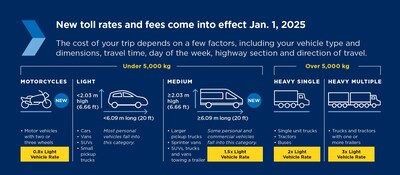An Unconventional Highway
The 407 ETR (Express Toll Route) has become a critical part of Ontario’s transportation landscape since its inception in 1997. As the first fully electronic toll highway in North America, it boasts a range of innovations aimed at improving traffic flow and commuter convenience. However, as Ontario’s roads continue to bear the burden of increased traffic, opinions are divided on the highway’s effectiveness and its financial implications for users.
The Toll Controversy
At the core of the discussion about 407 ETR is its pricing model, which, unlike many public highways, operates entirely on a toll basis. The current rates can be as high as 30 cents per kilometer during peak hours, a cost that has sparked criticism among Ontario drivers. Commuters have taken to social media to voice their dissatisfaction, with many expressing concerns about affordability. A recent tweet sparked a flurry of conversation: “$20 just for a few minutes on the 407? It’s highway robbery!” said one driver. While many understand the necessity of toll roads for funding infrastructure, the rising costs are becoming a significant concern.
Economic Impact
According to a report from the Ontario Ministry of Transportation, traffic on the 407 ETR saw a significant increase in 2022, with a record number of vehicles using the highway. This surge corresponds with the gradual return of pre-pandemic commuting patterns. Nevertheless, a growing segment of drivers is expressing that these tolls strain their budgets. As reported by Transport Canada, the toll road’s revenue continues to climb, reaching $1.2 billion in 2021—a stark contrast to the tax-funded road projects funding the majority of Ontario’s infrastructure.
Expert Opinions
Experts have mixed feelings about the highway’s future. Dr. Lisa Ramone, an urban development analyst at the University of Toronto, weighed in, stating, “While the 407 ETR provides much-needed relief for congested urban areas, the financial burden on everyday commuters is concerning. For many, the increasing costs may push them back onto overcrowded local roads, negating the highway’s efficiency benefits.” Her comments highlight the balance that needs to be struck between maintaining infrastructure and ensuring accessibility for all commuters.
Future Predictions
As Ontario grapples with a province-wide transportation strategy, the future of the 407 ETR will likely be a key focus. The government is under pressure to assess the toll structure and find ways to ease the financial burden while also enhancing the highway’s capacity. Advocates for public transport have also suggested that integrating more public transit options along the toll routes could provide a much-needed alternative for commuters.
The Bottom Line
The 407 ETR remains an integral part of Ontario’s highway system, serving as both a lifeline and a financial strain for many drivers. As discussions around toll rates heat up, the conversation is expected to evolve in the coming years. While there’s no clear solution on the horizon, the ongoing debate serves as a reminder that the future of transportation in Ontario requires careful consideration of economic implications, infrastructure growth, and public sentiment. Balancing these factors will be critical in shaping a road system that serves all Ontarians effectively.
